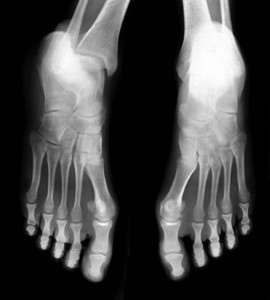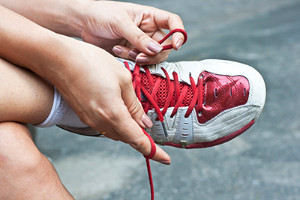Items filtered by date: June 2017
How Stress Fracture Healing Time May Be Linked to BMI
 A research team at Ohio State University spent three years studying the relationship between stress fractures and the required healing time to return to running on a Division 1 team. The team was able to find that the average healing time of a Grade V stress fracture was 17 weeks. A Grade V stress fracture is a fracture that is often ignored or mistreated to the point where surgery is required. These researchers compared the BMIs of women who were injured with those who were not, and found that women with BMIs lower than 19 were at a higher risk of developing stress fractures.
A research team at Ohio State University spent three years studying the relationship between stress fractures and the required healing time to return to running on a Division 1 team. The team was able to find that the average healing time of a Grade V stress fracture was 17 weeks. A Grade V stress fracture is a fracture that is often ignored or mistreated to the point where surgery is required. These researchers compared the BMIs of women who were injured with those who were not, and found that women with BMIs lower than 19 were at a higher risk of developing stress fractures.
Activities where too much pressure is put on the feet can cause stress fractures. To learn more, contact the podiatrists from Associated Podiatric Physicians, PA. Our doctors can provide the care you need to keep your pain free and on your feet.
Dealing with Stress Fractures of the Foot and Ankle
Stress fractures occur in the foot and ankle when muscles in these areas weaken from too much or too little use. The feet and ankles then lose support when walking or running from the impact of the ground. Since there is no protection, the bones receive the full impact of each step. Stress on the feet can cause cracks to form in the bones, thus creating stress fractures.
What Are Stress Fractures?
Stress fractures occur frequently in individuals whose daily activities cause great impact on the feet and ankles. Stress factors are most common among:
- Runners
- People affected with Osteoporosis
- Tennis or basketball players
- Gymnasts
- High impact workouts
Symptoms
Pain from the fractures occur in the area of the fractures and can be constant or intermittent. It will often cause sharp or dull pain with swelling and tenderness. Engaging in any kind of activity which involves high impact will aggravate pain.
If you have any questions please feel free to contact our office located in Hamilton Township, NJ. We offer the newest diagnostic and treatment technologies for all your foot and ankle needs.
Read more about Dealing with Stress Fractures of the Foot and AnkleHow Stress Fracture Healing Time May Be Linked to BMI
 A research team at Ohio State University spent three years studying the relationship between stress fractures and the required healing time to return to running on a Division 1 team. The team was able to find that the average healing time of a Grade V stress fracture was 17 weeks. A Grade V stress fracture is a fracture that is often ignored or mistreated to the point where surgery is required. These researchers compared the BMIs of women who were injured with those who were not, and found that women with BMIs lower than 19 were at a higher risk of developing stress fractures.
A research team at Ohio State University spent three years studying the relationship between stress fractures and the required healing time to return to running on a Division 1 team. The team was able to find that the average healing time of a Grade V stress fracture was 17 weeks. A Grade V stress fracture is a fracture that is often ignored or mistreated to the point where surgery is required. These researchers compared the BMIs of women who were injured with those who were not, and found that women with BMIs lower than 19 were at a higher risk of developing stress fractures.
Activities where too much pressure is put on the feet can cause stress fractures. To learn more, contact Donald Manger, DPM from Associated Podiatric Physicians, PA. Our doctor can provide the care you need to keep your pain free and on your feet.
Dealing with Stress Fractures of the Foot and Ankle
Stress fractures occur in the foot and ankle when muscles in these areas weaken from too much or too little use. The feet and ankles then lose support when walking or running from the impact of the ground. Since there is no protection, the bones receive the full impact of each step. Stress on the feet can cause cracks to form in the bones, thus creating stress fractures.
What Are Stress Fractures?
Stress fractures occur frequently in individuals whose daily activities cause great impact on the feet and ankles. Stress factors are most common among:
- Runners
- People affected with Osteoporosis
- Tennis or basketball players
- Gymnasts
- High impact workouts
Symptoms
Pain from the fractures occur in the area of the fractures and can be constant or intermittent. It will often cause sharp or dull pain with swelling and tenderness. Engaging in any kind of activity which involves high impact will aggravate pain.
If you have any questions please feel free to contact our office located in Hamilton Township, NJ . We offer the newest diagnostic and treatment technologies for all your foot and ankle needs.
Mariner’s Jean Segura Suffers Ankle Sprain
 Jean Segura of the Seattle Mariners recently sprained his ankle in a game against the Rockies. The shortstop said that “It was feeling really bad the first day,” and that he’s been feeling “much better” in the days following the injury. He suffered the ankle injury during the fourth inning as he slid into second base attempting to advance on a sac fly. Segura who batted .341 so far this season with an OPS of .391 has been called “impossible” to replace by minor leaguer Tyler Smith. His presence will surely be missed by the Mariners and Segura is eager to begin rehab so he can rejoin the team as soon as possible.
Jean Segura of the Seattle Mariners recently sprained his ankle in a game against the Rockies. The shortstop said that “It was feeling really bad the first day,” and that he’s been feeling “much better” in the days following the injury. He suffered the ankle injury during the fourth inning as he slid into second base attempting to advance on a sac fly. Segura who batted .341 so far this season with an OPS of .391 has been called “impossible” to replace by minor leaguer Tyler Smith. His presence will surely be missed by the Mariners and Segura is eager to begin rehab so he can rejoin the team as soon as possible.
Ankle sprains are common but need immediate attention. If you need your feet checked, contact the podiatrists from Associated Podiatric Physicians, PA. Our doctors can provide the care you need to keep you pain-free and on your feet.
How Does an Ankle Sprain Occur?
Ankle sprains take place when the ligaments in your ankle are torn or stretched beyond their limits. There are multiple ways that the ankle can become injured, including twisting or rolling over onto your ankle, putting undue stress on it, or causing trauma to the ankle itself.
What Are the Symptoms?
- Mild to moderate bruising
- Limited mobility
- Swelling
- Discoloration of the skin (depending on severity)
Preventing a Sprain
- Wearing appropriate shoes for the occasion
- Stretching before exercises and sports
- Knowing your limits
Treatment of a Sprain
Treatment of a sprain depends on the severity. Many times, people are told to rest and remain off their feet completely, while others are given an air cast. If the sprain is very severe, surgery may be required.
If you have suffered an ankle sprain previously, you may want to consider additional support such as a brace and regular exercises to strengthen the ankle.
If you have any questions please feel free to contact our office located in Hamilton Township, NJ. We offer the newest diagnostic and treatment technologies for all your foot and ankle needs.
Read more about Ankle SprainsMariner’s Jean Segura Suffers Ankle Sprain
 Jean Segura of the Seattle Mariners recently sprained his ankle in a game against the Rockies. The shortstop said that “It was feeling really bad the first day,” and that he’s been feeling “much better” in the days following the injury. He suffered the ankle injury during the fourth inning as he slid into second base attempting to advance on a sac fly. Segura who batted .341 so far this season with an OPS of .391 has been called “impossible” to replace by minor leaguer Tyler Smith. His presence will surely be missed by the Mariners and Segura is eager to begin rehab so he can rejoin the team as soon as possible.
Jean Segura of the Seattle Mariners recently sprained his ankle in a game against the Rockies. The shortstop said that “It was feeling really bad the first day,” and that he’s been feeling “much better” in the days following the injury. He suffered the ankle injury during the fourth inning as he slid into second base attempting to advance on a sac fly. Segura who batted .341 so far this season with an OPS of .391 has been called “impossible” to replace by minor leaguer Tyler Smith. His presence will surely be missed by the Mariners and Segura is eager to begin rehab so he can rejoin the team as soon as possible.
Ankle sprains are common but need immediate attention. If you need your feet checked, contact Donald Manger, DPM from Associated Podiatric Physicians, PA. Our doctor can provide the care you need to keep you pain-free and on your feet.
How Does an Ankle Sprain Occur?
Ankle sprains take place when the ligaments in your ankle are torn or stretched beyond their limits. There are multiple ways that the ankle can become injured, including twisting or rolling over onto your ankle, putting undue stress on it, or causing trauma to the ankle itself.
What Are the Symptoms?
- Mild to moderate bruising
- Limited mobility
- Swelling
- Discoloration of the skin (depending on severity)
Preventing a Sprain
- Wearing appropriate shoes for the occasion
- Stretching before exercises and sports
- Knowing your limits
Treatment of a Sprain
Treatment of a sprain depends on the severity. Many times, people are told to rest and remain off their feet completely, while others are given an air cast. If the sprain is very severe, surgery may be required.
If you have suffered an ankle sprain previously, you may want to consider additional support such as a brace and regular exercises to strengthen the ankle.
If you have any questions please feel free to contact our office located in Hamilton Township, NJ . We offer the newest diagnostic and treatment technologies for all your foot and ankle needs.
Why Blood Circulation is Important for Your Feet
 The most important function of our blood is to deliver oxygen from our lungs to the farthest parts of our body while removing carbon dioxide and other waste products. Hormones, immune cells, and signalling molecules all travel through the blood in order to support the body's vital processes. Poor blood circulation can occur as we age and is associated with various diseases. Numbness and tingling in the feet are common symptoms of poor blood flow. Coldness in the feet is also a symptom of poor blood flow since the blood is meant to keep the body at a stable, warm temperature. Lastly, foot pain may also be a sign of poor circulation. This may occur after standing or sitting down for a long period of time.
The most important function of our blood is to deliver oxygen from our lungs to the farthest parts of our body while removing carbon dioxide and other waste products. Hormones, immune cells, and signalling molecules all travel through the blood in order to support the body's vital processes. Poor blood circulation can occur as we age and is associated with various diseases. Numbness and tingling in the feet are common symptoms of poor blood flow. Coldness in the feet is also a symptom of poor blood flow since the blood is meant to keep the body at a stable, warm temperature. Lastly, foot pain may also be a sign of poor circulation. This may occur after standing or sitting down for a long period of time.
Poor circulation is a serious condition and needs immediate medical attention. If you have any concerns with poor circulation in your feet contact the podiatrists of Associated Podiatric Physicians, PA. Our doctors will treat your foot and ankle needs.
Poor Circulation in the Feet
Poor blood circulation in the feet and legs is can be caused by peripheral artery disease (PAD), which is the result of a buildup of plaque in the arteries.
Plaque buildup or atherosclerosis results from excess calcium and cholesterol in the bloodstream. This can restrict the amount of blood which can flow through the arteries. Poor blood circulation in the feet and legs are sometimes caused by inflammation in the blood vessels, known as vasculitis.
Causes
Lack of oxygen and oxygen from poor blood circulation restricts muscle growth and development. It can also cause:
- Muscle pain, stiffness, or weakness
- Numbness or cramping in the legs
- Skin discoloration
- Slower nail & hair growth
- Erectile dysfunction
Those who have diabetes or smoke are at greatest risk for poor circulation, as are those who are over 50. If you have poor circulation in the feet and legs it may be caused by PAD and is important to make changes to your lifestyle in order to reduce risk of getting a heart attack or stroke. Exercise and maintaining a healthy lifestyle will dramatically improve conditions.
As always, see a podiatrist as he or she will assist in finding a regimen that suits you. A podiatrist can also prescribe you any needed medication.
If you have any questions please feel free to contact our office located in Hamilton Township, NJ. We offer the newest diagnostic and treatment technologies for all your foot and ankle needs.
Read more about Causes, Symptoms, and Treatment of Poor Blood Circulation in the FeetWhy Blood Circulation is Important for Your Feet
 The most important function of our blood is to deliver oxygen from our lungs to the farthest parts of our body while removing carbon dioxide and other waste products. Hormones, immune cells, and signalling molecules all travel through the blood in order to support the body's vital processes. Poor blood circulation can occur as we age and is associated with various diseases. Numbness and tingling in the feet are common symptoms of poor blood flow. Coldness in the feet is also a symptom of poor blood flow since the blood is meant to keep the body at a stable, warm temperature. Lastly, foot pain may also be a sign of poor circulation. This may occur after standing or sitting down for a long period of time.
The most important function of our blood is to deliver oxygen from our lungs to the farthest parts of our body while removing carbon dioxide and other waste products. Hormones, immune cells, and signalling molecules all travel through the blood in order to support the body's vital processes. Poor blood circulation can occur as we age and is associated with various diseases. Numbness and tingling in the feet are common symptoms of poor blood flow. Coldness in the feet is also a symptom of poor blood flow since the blood is meant to keep the body at a stable, warm temperature. Lastly, foot pain may also be a sign of poor circulation. This may occur after standing or sitting down for a long period of time.
Poor circulation is a serious condition and needs immediate medical attention. If you have any concerns with poor circulation in your feet contact Donald Manger, DPM of Associated Podiatric Physicians, PA. Our doctor will treat your foot and ankle needs.
Poor Circulation in the Feet
Poor blood circulation in the feet and legs is can be caused by peripheral artery disease (PAD), which is the result of a buildup of plaque in the arteries.
Plaque buildup or atherosclerosis results from excess calcium and cholesterol in the bloodstream. This can restrict the amount of blood which can flow through the arteries. Poor blood circulation in the feet and legs are sometimes caused by inflammation in the blood vessels, known as vasculitis.
Causes
Lack of oxygen and oxygen from poor blood circulation restricts muscle growth and development. It can also cause:
- Muscle pain, stiffness, or weakness
- Numbness or cramping in the legs
- Skin discoloration
- Slower nail & hair growth
- Erectile dysfunction
Those who have diabetes or smoke are at greatest risk for poor circulation, as are those who are over 50. If you have poor circulation in the feet and legs it may be caused by PAD and is important to make changes to your lifestyle in order to reduce risk of getting a heart attack or stroke. Exercise and maintaining a healthy lifestyle will dramatically improve conditions.
As always, see a podiatrist as he or she will assist in finding a regimen that suits you. A podiatrist can also prescribe you any needed medication.
If you have any questions please feel free to contact our office located in Hamilton Township, NJ . We offer the newest diagnostic and treatment technologies for all your foot and ankle needs.
Tips for Finding Your Perfect Shoe
 The first step to getting into a proper running routine is to make sure you are wearing the right running shoes. The proper shoe will help to correct biomechanical issues and prevent injury. You should always go to a sneaker store that specializes in running shoes so that the workers can help you find a sneaker that fits your foot strike. There are three main types of runners based on foot strikes: overpronators (when the foot rolls inward too much), neutral pronators (feet roll inward slightly), and supinators (feet don’t roll inward enough). Certain running shoe stores will have you run on a treadmill so that the workers can best determine which shoe type will fit you properly. You will know the shoe is a good fit if you “feel like you want to go run immediately," said runner Dimity McDowell.
The first step to getting into a proper running routine is to make sure you are wearing the right running shoes. The proper shoe will help to correct biomechanical issues and prevent injury. You should always go to a sneaker store that specializes in running shoes so that the workers can help you find a sneaker that fits your foot strike. There are three main types of runners based on foot strikes: overpronators (when the foot rolls inward too much), neutral pronators (feet roll inward slightly), and supinators (feet don’t roll inward enough). Certain running shoe stores will have you run on a treadmill so that the workers can best determine which shoe type will fit you properly. You will know the shoe is a good fit if you “feel like you want to go run immediately," said runner Dimity McDowell.
If you are a runner, wearing the right running shoe is essential. For more information, contact the podiatrists from Associated Podiatric Physicians, PA. Our doctors can provide the care you need to keep you pain-free and on your feet.
Choosing the Right Running Shoe for Your Foot Type
To increase performance and avoid the risk of injury, it is important to choose the right running shoe based on your foot type. The general design of running shoes revolves around pronation, which is how the ankle rolls from outside to inside when the foot strikes the ground.
- Neutral runners are able to choose from a wide variety of shoes, including minimalist shoes or even going barefoot.
- Runners who overpronate, or experience an over-abundance of ankle rolling, should choose shoes that provide extra motion control and stability.
- Runners who underpronate, or supinate, have feet that have high arches and lack flexibility, preventing shock absorption. They require shoes with more flexibility and cushion.
If you have any questions please feel free to contact our office located in Hamilton Township, NJ. We offer the newest diagnostic and treatment technologies for all your foot and ankle needs.
Read more about Choosing the Right Running Shoe for Your Foot TypeTips for Finding Your Perfect Shoe
 The first step to getting into a proper running routine is to make sure you are wearing the right running shoes. The proper shoe will help to correct biomechanical issues and prevent injury. You should always go to a sneaker store that specializes in running shoes so that the workers can help you find a sneaker that fits your foot strike. There are three main types of runners based on foot strikes: overpronators (when the foot rolls inward too much), neutral pronators (feet roll inward slightly), and supinators (feet don’t roll inward enough). Certain running shoe stores will have you run on a treadmill so that the workers can best determine which shoe type will fit you properly. You will know the shoe is a good fit if you “feel like you want to go run immediately," said runner Dimity McDowell.
The first step to getting into a proper running routine is to make sure you are wearing the right running shoes. The proper shoe will help to correct biomechanical issues and prevent injury. You should always go to a sneaker store that specializes in running shoes so that the workers can help you find a sneaker that fits your foot strike. There are three main types of runners based on foot strikes: overpronators (when the foot rolls inward too much), neutral pronators (feet roll inward slightly), and supinators (feet don’t roll inward enough). Certain running shoe stores will have you run on a treadmill so that the workers can best determine which shoe type will fit you properly. You will know the shoe is a good fit if you “feel like you want to go run immediately," said runner Dimity McDowell.
If you are a runner, wearing the right running shoe is essential. For more information, contact Donald Manger, DPM from Associated Podiatric Physicians, PA. Our doctor can provide the care you need to keep you pain-free and on your feet.
Choosing the Right Running Shoe for Your Foot Type
To increase performance and avoid the risk of injury, it is important to choose the right running shoe based on your foot type. The general design of running shoes revolves around pronation, which is how the ankle rolls from outside to inside when the foot strikes the ground.
- Neutral runners are able to choose from a wide variety of shoes, including minimalist shoes or even going barefoot.
- Runners who overpronate, or experience an over-abundance of ankle rolling, should choose shoes that provide extra motion control and stability.
- Runners who underpronate, or supinate, have feet that have high arches and lack flexibility, preventing shock absorption. They require shoes with more flexibility and cushion.
If you have any questions please feel free to contact our office located in Hamilton Township, NJ . We offer the newest diagnostic and treatment technologies for all your foot and ankle needs.
